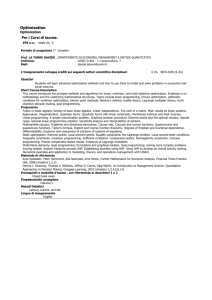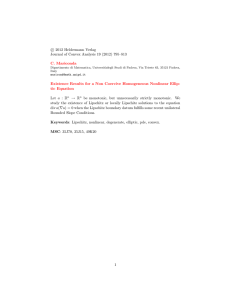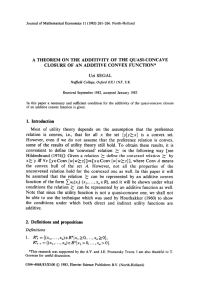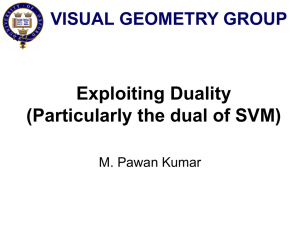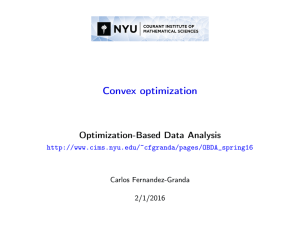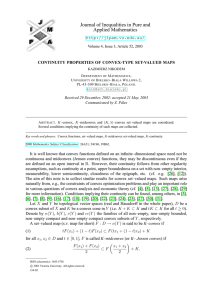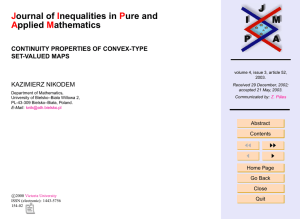DESCENT METHODS FOR CONVEX OPTIMIZATION PROBLEMS IN BANACH SPACES
advertisement
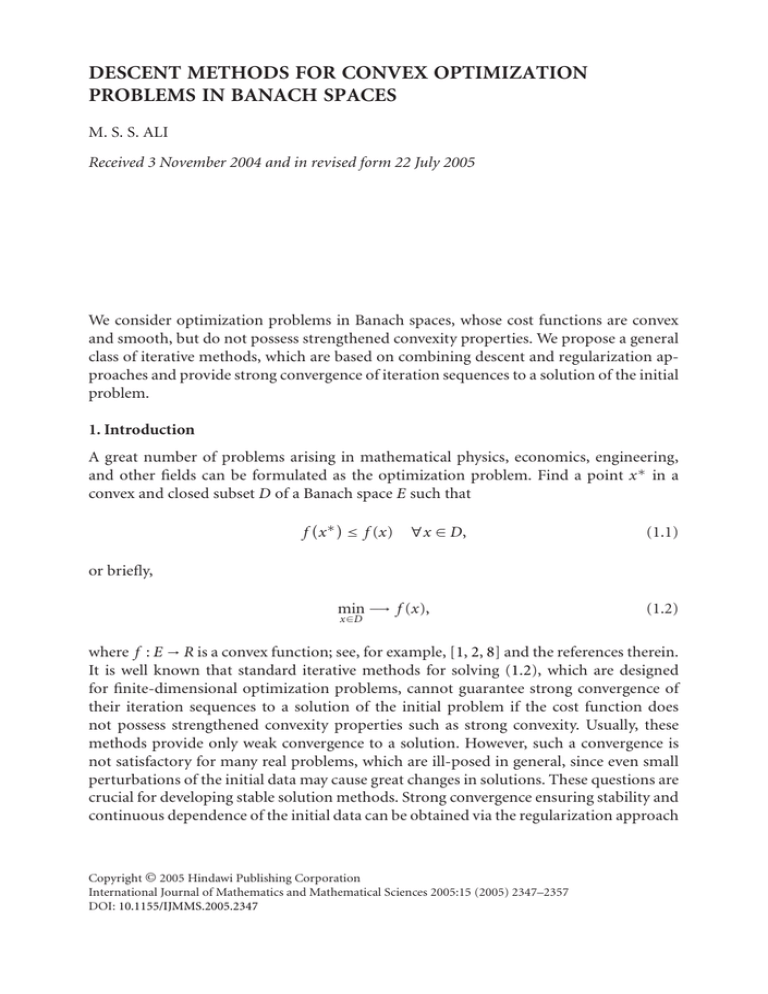
DESCENT METHODS FOR CONVEX OPTIMIZATION
PROBLEMS IN BANACH SPACES
M. S. S. ALI
Received 3 November 2004 and in revised form 22 July 2005
We consider optimization problems in Banach spaces, whose cost functions are convex
and smooth, but do not possess strengthened convexity properties. We propose a general
class of iterative methods, which are based on combining descent and regularization approaches and provide strong convergence of iteration sequences to a solution of the initial
problem.
1. Introduction
A great number of problems arising in mathematical physics, economics, engineering,
and other fields can be formulated as the optimization problem. Find a point x∗ in a
convex and closed subset D of a Banach space E such that
f x∗ ≤ f (x) ∀x ∈ D,
(1.1)
min −→ f (x),
(1.2)
or briefly,
x ∈D
where f : E → R is a convex function; see, for example, [1, 2, 8] and the references therein.
It is well known that standard iterative methods for solving (1.2), which are designed
for finite-dimensional optimization problems, cannot guarantee strong convergence of
their iteration sequences to a solution of the initial problem if the cost function does
not possess strengthened convexity properties such as strong convexity. Usually, these
methods provide only weak convergence to a solution. However, such a convergence is
not satisfactory for many real problems, which are ill-posed in general, since even small
perturbations of the initial data may cause great changes in solutions. These questions are
crucial for developing stable solution methods. Strong convergence ensuring stability and
continuous dependence of the initial data can be obtained via the regularization approach
Copyright © 2005 Hindawi Publishing Corporation
International Journal of Mathematics and Mathematical Sciences 2005:15 (2005) 2347–2357
DOI: 10.1155/IJMMS.2005.2347
2348
Descent methods for convex optimization problems
(see [9]), when the initial problem is replaced with a sequence of perturbed well-posed
problems. There exist a great number of applied problems in physics, mechanics, optimal control, economics, engineering, and other fields whose stable solutions require the
regularization approach; see [9, 10, 11] and the references therein.
However, each perturbed problem has nonlinear optimization form and its solution
can be found only approximately. In order to avoid the difficulty of solving perturbed
problems within a prescribed accuracy, some other regularization techniques, such as
averaging and iterative regularization, were proposed for obtaining implementable algorithms with strong convergence of their iteration sequences (see, e.g., [11]). However, due
to their divergent series step-size rules, convergence may be very slow.
Very recently, another approach to constructing implementable and strongly convergent algorithms for variational inequalities was proposed in [4, 5]. This approach is based
on applying a descent algorithm for perturbed problems which are obtained by adding
the identity map, and introducing artificial gap functions, which allow for estimating error bounds.
In this paper, motivated by the above approach, we intend to present a rather general
class of implementable algorithms for solving the convex optimization problem (1.2) in
a reflexive Banach space. These algorithms have a flexible structure in the sense that they
can be easily adjusted for essential features of each particular problem under consideration. At the same time, they provide the strong convergence of the iteration sequence
if the initial problem is solvable. Namely, we introduce a general class of perturbation
functions and utilize its properties for designing gap functions and descent methods.
2. Regularization of optimization problems
In this section, we give a strong convergence result of approximate solutions of perturbed
problems. First we recall several definitions and auxiliary properties. A function ψ : E → R
is said to be uniformly convex (see [6]) if there exists a continuously increasing function
θ : R → R such that θ(0) = 0 and that for all x, y ∈ E and for each λ ∈ [0,1], we have
ψ λx + (1 − λ)y ≤ λψ(x) + (1 − λ)ψ(y) − λ(1 − λ)θ x − y x − y .
(2.1)
If θ(τ) = κτ for κ > 0, then ψ is called a strongly convex function. One can see that the
class of uniformly convex functions is rather broad. These functions possess several very
useful properties (see [6] and also [10]), which are listed in the following proposition.
Proposition 2.1. Suppose that ψ : E → R is a uniformly convex and lower semicontinuous
function. Then,
(i) ψ is bounded from below on E;
(ii) for each µ, the level set Xµ = {x ∈ E | ψ(x) ≤ µ} is bounded;
(iii) if ψ is differentiable, then, for each pair of points x, y ∈ E,
ψ(y) − ψ(x) ≥ ∇ψ(x), y − x + θ x − y x − y ,
∇ψ(y) − ∇ψ(x), y − x ≥ 2θ x − y x − y .
(2.2)
(2.3)
M. S. S. Ali 2349
These properties allow us to easily deduce the existence and uniqueness results of solutions for uniformly convex optimization problems.
Proposition 2.2 [10, Chapter 1, Section 3, Theorem 9]. Suppose that D is a nonempty,
convex, and closed subset of a reflexive Banach space E,ψ : E → R is a uniformly convex and
lower semicontinuous function. Then the optimization problem
min −→ ψ(x)
(2.4)
x ∈D
has the unique solution x∗ , moreover,
ψ(x) − ψ x∗ ≥ θ x − x∗ x − x∗ ∀x ∈ D.
(2.5)
In what follows, we will use the following basic assumptions on problem (1.2).
(A1) D is a nonempty, convex, and closed subset of a reflexive Banach space E.
(A2) f : E → R is a convex and lower semicontinuous function.
(A3) The solution set D∗ of problem (1.2) is nonempty.
In order to apply the Tikhonov regularization approach to problem (1.2), we introduce
an auxiliary function ϕ : E → R, which satisfies the following property.
(B1) ϕ : E → R is a uniformly convex and lower semicontinuous function.
Now we define the perturbed optimization problem
min −→ f (x) + εϕ(x),
for ε > 0.
x ∈D
(2.6)
Note that the choice ϕ(x) = 0.5αx2 , where α is the regularization parameter, is the classical Tikhonov regularization. For brevity, set
fε (x) = f (x) + εϕ(x),
(2.7)
then the function fε is clearly uniformly convex and lower semicontinuous. From
Proposition 2.2, it follows that problem (2.6) has a unique solution, which will be denoted by xε .
We now establish the convergence result for approximate solutions of problem (2.6) to
a solution of problem (1.2), which can be viewed as a modification of the known results
from [3, 9, 10, 11].
Proposition 2.3. Suppose that assumptions (A1)–(A3) and (B1) are fulfilled. Then any
sequence {zk }, which is generated in conformity with the rules
zk ∈ D,
k
z − x ε k ≤ µ k ,
εk 0, {µk } 0,
(2.8)
converges strongly to the unique solution xn∗ of the problem
min −→ ϕ(x).
x ∈D ∗
(2.9)
2350
Descent methods for convex optimization problems
Proof. First we note that the set D∗ is nonempty, convex, and closed. Hence by Proposition 2.2, problem (2.9) has a unique solution. Next, we proceed to show that
lim xεk = xn∗ .
(2.10)
k→∞
Since fε is uniformly convex with function εθ, we have from (2.5) that
f x∗ + εϕ xε ≤ f xε + εϕ xε ≤ f x∗ + εϕ x∗ − εθ̃ x∗ − xε (2.11)
for each ε > 0 and for an arbitrary point x∗ ∈ D∗ , where θ̃(x∗ − xε ) = θ(x∗ − xε )x∗ −
xε . It follows that
θ̃ xε − x∗ ≤ ϕ x∗ − ϕ xε ,
(2.12)
but ϕ is bounded from below on E, hence the sequence {xεk } is bounded, that is, it has
weak limit points. If x is an arbitrary weak limit point of {xεk }, then (2.11) yields
f x∗ ≤ f xε ≤ f x∗ + ε ϕ x∗ − ϕ xε ,
(2.13)
that is, x ∈ D∗ . Setting x∗ = xn∗ and taking the corresponding limit in (2.12), we now
obtain
θ̃ x − xn∗ ≤ ϕ xn∗ − ϕ(x ) ≤ 0,
(2.14)
hence xn∗ = x and (2.10) is true. Next, by definition,
k
z − x∗ ≤ zk − xεk + xεk − x∗ ≤ xεk − x∗ + µk .
(2.15)
It follows now from (2.8) and (2.10) that {zk } converges strongly to xn∗ .
n
n
n
Thus, in order to present an implementable algorithm for solving problem (1.2), we
have to find an approximate solution zk of each perturbed problem (2.6) with the prescribed accuracy µk in a finite number of iterations.
3. Properties of the perturbed auxiliary problem
In this section, we establish several results which will be used for construction and substantiation of an iterative solution method for problem (2.6). Recall that, on account of
Proposition 2.2, this problem has a unique solution if assumptions (A1), (A2), and (B1)
are fulfilled. Nevertheless, in order to construct a convergent solution method, we will
make use of the additional differentiability condition. More precisely, we replace (A2)
and (B1) with the following assumptions.
(A2 ) f : E → R is convex and has the Lipschitz continuous gradient map ∇ f : E → E∗ ,
where E∗ is the conjugate space.
(B1 ) ϕ : E → R is uniformly convex and has the Lipschitz continuous gradient map ∇ϕ :
E → E∗ .
Observe that the convexity of a function and the continuity of its gradient map imply
lower semicontinuity (see, e.g., [1, Chapter I, Theorem 1.1]), so that (A2 ) and (B1 )
imply (A2) and (B1), respectively.
M. S. S. Ali 2351
We start our considerations from the standard equivalence results for problem (2.6),
which are modifications of those in [2, Chapter 2, Propositions 2.1 and 2.2].
Lemma 3.1. Suppose that (A1), (A2 ), and (B1 ) are fulfilled. Then problem (2.6) is equivalent to each of the following variational inequalities:
(i) find xε ∈ D such that
∇ f xε ,x − xε + ε ϕ(x) − ϕ xε ≥ 0
∀x ∈ D,
(3.1)
(ii) find xε ∈ D such that
∇ f xε + ε∇ϕ xε ,x − xε ≥ 0
∀x ∈ D.
(3.2)
Proof. Obviously, (3.2) is the classical necessary and sufficient condition of optimality
for (2.6) (see, e.g., [1, Chapter I, Theorem 0.4]). Utilizing the standard inequality for the
differentiable convex function ϕ:
ϕ(x) − ϕ xε ≥ ∇ϕ xε ,x − xε
(3.3)
in (3.2) (see also (2.2)), we obtain the implication (3.2)⇒(3.1). Utilizing the same property with respect to f in (3.1), we obtain (3.1)⇒(2.6), but (2.6)⇔(3.2). Therefore, the
assertion is true.
We introduce the auxiliary function
Φε (x, y) = ∇ f (x), y − x + ε ϕ(y) − ϕ(x) .
(3.4)
Since Φε (x, ·) is clearly uniformly convex and lower semicontinuous under (A2 ) and
(B1 ), the optimization problem
min −→ Φε (x, y)
(3.5)
y ∈D
has a unique solution, which will be denoted by y ε (x). Observe that the function Φε in
(3.5) can be in principal replaced with the simplified expression
Φ̃ε (x, y) = ∇ f (x), y + εϕ(y).
(3.6)
Anyway, taking into account Lemma 3.1, we obtain immediately the fixed point charac
terization of the solution of (2.6).
Proposition 3.2. If (A1), (A2 ), and (B1 ) are fulfilled, then xε is a solution of (2.6) if and
only if xε = y ε (xε ).
Observe that
ψε (x) = − min Φε (x, y) = −Φε x, y ε (x)
y ∈D
(3.7)
2352
Descent methods for convex optimization problems
can be regarded as the primal gap function for problem (3.1) or, equivalently, as the regularized gap function for problem (3.2) with the regularization term ε[ϕ(x) − ϕ(xε ) −
∇ϕ(xε ),x − xε ] (see [4, 7]). The idea of utilizing auxiliary terms in regularization and
proximal point methods for constructing smooth gap functions was first suggested in [4]
and called the nonlinear smoothing approach. This approach enables us to avoid including additional parameters and functions in descent methods and to propose very flexible
computational schemes.
We now establish an error bound for the auxiliary problem (2.6).
Proposition 3.3. Suppose that (A1), (A2 ), and (B1 ) are fulfilled. Then, for each ε > 0,
2εθ x − xε ≤ L f + 2εLϕ x − y ε (x)
∀x ∈ D,
(3.8)
where L f and Lϕ are the Lipschitz constants for ∇ f and ∇ϕ, respectively.
Proof. Fix x ∈ D and for brevity, set y = y ε (x). Then, due to Lemma 3.1, we have
∇ fε xε , y − xε ≥ 0,
∇ f (x) + ε∇ϕ(y),xε − y ≥ 0,
(3.9)
(3.10)
where the second inequality follows from the same optimality criterion applied to problem (3.5). Adding these inequalities gives
∇ fε xε − ∇ fε (x), y − xε + ε ∇ϕ(y) − ∇ϕ(x),xε − y ≥ 0.
(3.11)
Using (A2 ), (B1 ), and Proposition 2.1(iii), we have
2εθ x − xε x − xε ≤ ∇ fε (x) − ∇ fε xε ,x − xε
= ∇ fε (x) − ∇ fε xε ,x − y + ∇ fε (x) − ∇ fε xε , y − xε .
(3.12)
Applying now the above inequality and the monotonicity of ∇ϕ yields
2εθ x − xε x − xε ≤ ∇ fε (x) − ∇ fε xε ,x − y + ε ∇ϕ(y) − ∇ϕ(x),xε − x
+ ε ∇ϕ(y) − ∇ϕ(x),x − y
≤ ∇ f (x) − ∇ f xε ,x − y + ε ∇ϕ(x) − ∇ϕ xε ,x − y
+ ε ∇ϕ(y) − ∇ϕ(x),xε − x
≤ L f x − xε x − y + εLϕ x − xε x − y + εLϕ y − xxε − x,
(3.13)
hence
2εθ x − xε ≤ L f + 2εLϕ x − y ,
and the result follows.
(3.14)
M. S. S. Ali 2353
We now give the basic descent property which utilizes the direction y ε (x) − x.
Proposition 3.4. Suppose that (A1), (A2 ), and (B1 ) are fulfilled. Then, for each ε > 0,
∇ fε (x), y ε (x) − x ≤ −ε ∇ϕ y ε (x) − ∇ϕ(x), y ε (x) − x
≤ −2εθ y ε (x) − x y ε (x) − x ∀x ∈ D.
(3.15)
Proof. Fix x ∈ D and again set, for brevity, y = y ε (x). Then, writing the optimality condition for problem (3.5), we have
∇ f (x) + ε∇ϕ(y),z − y ≥ 0,
∀z ∈ D,
(3.16)
(cf. (3.10)). Setting z = x in this inequality gives
∇ fε (x),x − y + ε ∇ϕ(y) − ∇ϕ(x),x − y ≥ 0.
(3.17)
Thus the first inequality in (3.15) holds. The second inequality now follows from Proposition 2.1(iii).
Additionally, we give the continuity property for the mapping x → y ε (x).
Proposition 3.5. If (A1), (A2 ), and (B1 ) are fulfilled, then x → y ε (x) is continuous.
Proof. Take arbitrary points x ,x ∈ D and set y = y ε (x ), y = y ε (x ). Using the optimality condition (3.16) gives
∇ f (x ) + ε∇ϕ(y ), y − y ≥ 0,
∇ f (x ) + ε∇ϕ(y ), y − y ≥ 0.
(3.18)
Adding these inequalities and taking into account (3.2), we obtain
∇ f (x ) − ∇ f (x ), y − y ≥ ε ∇ϕ(y ) − ∇ϕ(y ), y − y ≥ 2εθ y − y y − y ,
(3.19)
hence
L f x − x ≥ 2εθ y − y ,
which implies the continuity of x → y ε (x).
(3.20)
4. Descent method for convex optimization
First we describe a descent algorithm for solving the auxiliary problem (2.6) for a fixed
ε > 0. This algorithm follows the general iteration scheme from [7].
Since the function ϕ may be chosen rather arbitrarily within rule (B1 ), this algorithm
admits in fact a wide variety of iteration schemes. That is, one can choose ϕ to be suitable for approximation of properties of the cost function f in (1.2), for solution of the
auxiliary problem (3.5), and for computation of the gradient ∇ϕ. These properties make
Algorithm 4.1 very flexible in comparison with the usual gradient schemes.
2354
Descent methods for convex optimization problems
Step 1. Choose a point x0 ∈ D and numbers α ∈ (0,1) and β ∈ (0,1). Set i = 0.
Step 2. Compute y i = y ε (xi ) and set di = y i − xi .
Step 3. Find m as the smallest nonnegative integer such that
fε xi + βm di ≤ fε xi − αβm ε ∇ϕ y i − ∇ϕ(xi ),di ,
(4.1)
set λi = βm , xi+1 = xi + λi di , i = i + 1 and go to Step 2.
Algorithm 4.1
The next theorem presents a convergence result for Algorithm 4.1.
Theorem 4.1. Suppose that assumptions (A1), (A2 ), and (B1 ) are satisfied. Then any
sequence {xi }, generated by Algorithm 4.1, converges strongly to the unique solution xε of
problem (2.6) for a given ε > 0.
Proof. It has been mentioned that (2.6) has a unique solution due to Proposition 2.2. By
(A2 ) and (B1 ), ∇ fε is Lipschitz continuous with constant L = L f + εLϕ , where L f and
Lϕ are the corresponding Lipschitz constants for ∇ f and ∇ϕ, respectively. It follows that
the well-known inequality (see, e.g., [10, Chapter 2, Section 3]) holds:
2
fε xi + λdi − fε xi ≤ λ ∇ fε (xi ),di + 0.5λ2 Ldi .
(4.2)
In view of (3.15), we have
2
2
fε xi + λdi − fε xi ≤ −λε ∇ϕ y i − ∇ϕ xi ,di + 0.5λ2 Ldi .
(4.3)
If
ε ∇ϕ y i − ∇ϕ xi ,di − 0.5λLdi ≥ αε ∇ϕ y i − ∇ϕ xi ,di
(4.4)
is satisfied for a positive λ, then the line-search procedure in Algorithm 4.1 becomes implementable. However, (4.4) is equivalent to
2 λ ≤ 2(1 − α)ε ∇ϕ y i − ∇ϕ xi ,di / Ldi (4.5)
and (see (3.15)) we have
∇ϕ y i − ∇ϕ xi ,d i ≥ 2θ d i d i .
(4.6)
So (4.4) is satisfied if
λ ≤ 4(1 − α)εθ di / Ldi .
(4.7)
By (A1), (A2 ), and (B1 ), fε is uniformly convex, hence it is bounded from below on D
and the level set D0 = {x ∈ D | fε (x) ≤ fε (x0 )} is also bounded because of Proposition 2.1.
M. S. S. Ali 2355
But the sequence { fε (xi )} is nonincreasing due to (4.1), hence, by Proposition 3.5,
d i ≤ C < +∞
for i = 0,1,... .
(4.8)
Suppose that
i
d ≥ l > 0
for i = 0,1,... .
(4.9)
Choosing λ ≤ λ = 4(1 − α)εθ(l)/(LC), we see that
fε xi + λdi − fε xi ≤ −2αλεθ di di ,
(4.10)
that is, λi ≥ λ = min{β,βλ }. It follows that
fε xi − fε xi+1 ≥ 2αλ εθ di di −→ 0
(4.11)
as i → +∞, which is a contradiction. Therefore, there exists a subsequence {is } such that
d is → 0 as is → +∞, that is, y ε (xis ) − xis → 0, and by (3.8), xis − xε → 0 as is → +∞.
It means that xε is a strong limit point of {xi }. Since { fε (xi )} is nonincreasing, it means
that
lim fε xi = fε xε .
i→∞
(4.12)
Applying now (2.5) with ψ = fε , we conclude that the whole sequence {xi } converges
strongly to xε and the result follows.
Being based on the above result, we can approximate the solution xε of each perturbed
problem (2.6) with any prescribed accuracy in a finite number of iterations. In order to
construct such a combined regularization and descent method, we will make use of error bound (3.8). The corresponding solution method for the initial convex optimization
problem (1.2) can be described as follows.
Method. Choose a point z0 ∈ D, a number δ > 0, and a positive sequence {εk } 0. For
each k = 1,2,..., we have a point zk−1 ∈ D; apply Algorithm 4.1 with x0 = zk−1 , ε = εk and
construct a sequence {xi } until
i
d ≤ ε1+δ .
(4.13)
Then we set zk = xi and increase k = k + 1.
We now show that our method is fully implementable and generates a strongly convergent sequence.
Theorem 4.2. Suppose that assumptions (A1), (A2 ), (A3), and (B1 ) are satisfied and that
a sequence {zk } is generated by the method. Then,
(i) each kth iteration of the method is finite;
(ii) the sequence {zk } converges strongly to the point xn∗ , which is the unique solution of
problem (2.9).
2356
Descent methods for convex optimization problems
Proof. First we note that the inequality (4.13) will be satisfied in a finite number of iterations, since di → 0 as i → +∞ due to Theorem 4.1 and Propositions 3.2 and 3.5. Hence,
assertion (i) of the theorem is true. Next, combining (4.13) and (3.8) yields
2εθ xi − xε ≤ L f + 2εLϕ ε1+δ ,
θ zk − xεk ≤ Fεkδ ,
(4.14)
0 < F < +∞
since {εk } 0. Moreover, it follows that
k
z − x ε k ≤ µ k
(4.15)
for some sequence {µk } 0. We now see that all the assumptions of Proposition 2.3 are
satisfied. Therefore, assertion (ii) of the theorem also holds.
5. Numerical experiments
As has been mentioned, a great number of applied problems in physics, mechanics, optimal control, economics, engineering are solved via the regularization approach; for example, see [9, 10, 11]. In this section, we present some preliminary results of numerical
experiments that illustrate convergence properties of the combined regularization and
descent method.
We chose a well-known ill-posed optimal control problem; see, for example, [10, page
162, Example 2]. The problem is to minimize the functional
f (x) =
1
0
u2 (t)dt,
(5.1)
subject to
u̇(t) = x(t),
t ∈ [0,1], u(0) = 0,
x(t) ∈ X = x(t) ∈ L2 [0,1] | |x(t)| ≤ 1 a.e. .
(5.2)
It is easy to see that the cost functional is convex and differentiable, that the optimal
control x∗ (·) ≡ 0 is determined uniquely, and that the minimal value f ∗ = 0. At the
same time, the sequence xk (t) = sin(2πkt) minimizes the cost functional, but
∗
x (·) − xk (·)
L2 [0,1]
= 0.5,
(5.3)
that is, it is not norm converging to the solution. It means that the initial problem is
ill-posed.
We apply the described combined regularization and descent method to solve this
problem. We implement the method with double-precision arithmetic with piecewise
constant approximation of the control function x(t). We used the stopping criterion
k
x − z k ≤ η
(5.4)
in Algorithm 4.1. The total number of iterations for several values of the accuracy η and
the number N of pieces of control approximation is given in Table 6.1.
M. S. S. Ali 2357
Table 6.1. ε = 1.
N
50
100
η = 0.1
2
2
η = 0.01
4
4
η = 0.001
5
5
η = 0.0001
8
8
η = 0.00001
12
12
The results show that the convergence of the method is rather stable and rapid for
ill-posed problems.
6. Conclusions
Thus, we have presented a general iterative scheme of implementable algorithms with
strong convergence for convex optimization problems. Although this scheme is used for
differentiable problems, the above approach may be viewed as a basis for nondifferentiable problems.
Acknowledgments
The author is grateful to Professor I. V. Konnov for his suggestion of the subject of this
paper and for useful discussions of the results. The author is also grateful to referees
whose suggestions improved the exposition of the paper.
References
[1]
[2]
[3]
[4]
[5]
[6]
[7]
[8]
[9]
[10]
[11]
J. Céa, Optimisation: Théorie et algorithmes, Méthodes Mathématiques de l’Informatique, vol. 2,
Dunod, Paris, 1971.
I. Ekeland and R. Temam, Convex Analysis and Variational Problems, Studies in Mathematics and Its Applications, vol. 1, North-Holland, Amsterdam; American Elsevier, New York,
1976.
V. G. Karmanov, Mathematical Programming, Nauka, Moscow, 1986.
I. V. Konnov, Approximate methods for primal-dual mixed variational inequalities, Russian
Math. (Iz. VUZ) 44 (2000), no. 12, 55–66.
I. V. Konnov, S. Kum, and G. M. Lee, On convergence of descent methods for variational inequalities in a Hilbert space, Math. Methods Oper. Res. 55 (2002), no. 3, 371–382.
E. S. Levitin and B. T. Polyak, Constrained minimization methods, Comput. Math. Math. Phys.
6 (1966), 1–50.
M. Patriksson, Cost approximation: a unified framework of descent algorithms for nonlinear programs, SIAM J. Optim. 8 (1998), no. 2, 561–582.
B. T. Polyak, Introduction to Optimization, Translations Series in Mathematics and Engineering,
Optimization Software, New York, 1987.
A. N. Tikhonov and V. Y. Arsenin, Solutions of Ill-Posed Problems, Scripta Series in Mathematics,
V. H. Winston & Sons, Washington, D.C.; John Wiley & Sons, New York, 1977.
F. P. Vasil’yev, Methods of Solution of Extremal Problems, Nauka, Moscow, 1981.
V. V. Vasin and A. L. Ageev, Ill-Posed Problems with a Priori Information, Inverse and Ill-posed
Problems Series, VSP, Utrecht, 1995.
M. S. S. Ali: Department of Mathematics, Faculty of Education, Ain Shams University, Cairo, Egypt
E-mail address: mssali5@hotmail.com
